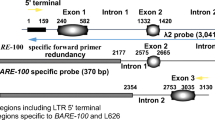Abstract
Tnr1 is a repetitive sequence in rice with several features characteristic of a transposable DNA element. Its copy number was estimated to be about 3500 per haploid genome by slot-blot hybridization. We have isolated six members of Tnr1 located at different loci by PCR (polymerase chain reaction) and determined their nucleotide sequences. The Tnr1 elements were similar in size and highly homologous (about 85%) to the Tnr1 sequence identified first in the Waxy gene in Oryza glaberrima. A consensus sequence of 235 by could be derived from the nucleotide sequences of all the Tnr1 members. The consensus sequence showed that base substitutions occurred frequently in Tnr1 by transition, and that Tnr1 has terminal inverted repeat sequences of 75 bp. Almost all the chromosomal sequences that flank the Tnr1 members were 5′-PuTA-3′ and 5′-TAPy-3′, indicating that Tnr1 transposed to 5′-PuTAPy-3′ sites, duplicating the TA sequence. PCR-amplified fragments from some rice species did not contain the Tnr1 members at corresponding loci. Comparison of nucleotide sequences of the fragments with or without a Tnr1 member confirmed preferential transposition of Tnr1 to 5′-PuTAPy-3′ sites, duplicating the TA sequence. One amplified sequence suggested that imprecise excision had occurred to remove a DNA segment containing a Tnr1 member and its neighboring sequences at the Waxy locus of rice species with genome types other than AA. We also present data that may suggest that Tnr1 is a defective form of an autonomous transposable element.
Similar content being viewed by others
References
Arumaganathan K, Earle ED (1991) Nuclear DNA content of some important plant species. Plant Mol Biol Rep 9:208–218
Baker B, Schell J, Lšrz H, Fedoroff NV (1986) Transposition of the maize controlling element Activator in tobacco. Proc Natl Acad Sci USA 83:4844–4848
Bureau TE, Wessler SR (1992) Tourist: a large family of small inverted repeated elements frequently associated with maize genes. Plant Cell 4:1283–1294
Coen ES, Robbins TP, Almeida J, Hudson A, Carpenter R (1989) Consequences and mechanism of transposition in Antirrhinum majus. In: Berg DE, Howe MM (eds) Mobile DNA. American Society for Microbiology, Washington, DC, pp 413–436
Erlich HA (ed) (1989) PCR technology, principles and applications for DNA amplification. Stockton Press
Fedoroff NV (1989) Maize transposable elements. In: Berg DE, Howe MM (eds), Mobile DNA. American Society for Microbiology, Washington DC, pp 375–411
Gierl A, Saedler H (1992) Plant-transposable elements and gene tagging. Plant Mol Biol 19:39–49
Henikoff S (1992) Detection of Caenorhabditis transposon homologs in diverse organisms. New Biol 4:382–388
Huang N, Sutliff TD, Litts JC, Rodriguez RL (1990) Classification and characterization of the rice α-amylase multigene family. Plant Mol Biol 14:655–668
Jaraczewski JW, Jahn CL (1993) Elimination of Tec elements involves a novel excision process. Genes Dev 7:95–105
Messing J (1983) New M13 vectors for cloning. Methods Enzymol 101:20–78
Mochizuki K, Umeda M, Ohtsubo H, Ohtsubo E (1992) Characterization of a plant SINE, p-SINE1, in rice genomes. Jpn J Genet 67:155–166
Mori I, Benian G M, Moreman DG, Waterston RH (1988) The transposon Tcl of C. elegans recognizes specific target sequences for integration. Proc Natl Acad Sci USA 85:861–864
Ochman H, Gerber AS, Hartl DL (1988) Genetic applications of an inverse polymerase chain reaction. Genetics 120:621–623
Ohtsubo H, Umeda M, Ohtsubo E (1991) Organization of DNA sequences highly repeated in tandem in rice genomes. Jpn J Genet 66:241–254
Saiki RK, Gelfand DH, Stoffel S, Scharf SJ, Higuchi R, Horn GT, Mullis KB, Erlich HA (1988) Primer-directed enzymatic amplification of DNA with a thermostable DNA polymerase. Science 239:487–491
Sanger F, Nicklen S, Coulson AR (1977) DNA sequencing with chain-terminating inhibitors. Proc Natl Acad Sci USA 74:5463–5467
Schwarz-Sommer Z, Gierl A, Cuypers H, Peterson PA, Saedler H (1985) Plant transposable elements generate the DNA sequence diversity needed in evolution. EMBO J 4:591–597
Tenzen T, Ohtsubo E (1991) Preferential transposition of an IS630-associated composite transposon to TA in the 5′-CTAG-3′ sequence. J Bacteriol 173:6207–6212
Tenzen T, Matsutani S, Ohtsubo E (1990) Site-specific transposition of insertion sequence IS630. J Bacteriol 172:3830–3836
Umeda M, Ohtsubo H, Ohtsubo E (1991) Diversification of the rice Waxy gene by insertion of mobile DNA elements into introns. Jpn J Genet 66:569–586
Vieira J, Messing J (1987) Production of single-stranded plasmid DNA. Methods Enzymol 153:3–11
Author information
Authors and Affiliations
Additional information
Communicated by M. Sckiguchi
Rights and permissions
About this article
Cite this article
Tenzen, T., Matsuda, Y., Ohtsubo, H. et al. Transposition of Tnr1 in rice genomes to 5′-PuTAPy-3′ sites, duplicating the TA sequence. Molec. Gen. Genet. 245, 441–448 (1994). https://doi.org/10.1007/BF00302256
Received:
Accepted:
Issue Date:
DOI: https://doi.org/10.1007/BF00302256




